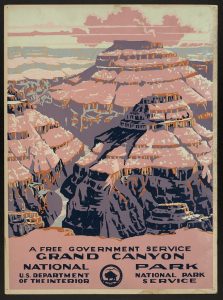“See America First,” advertisement for Great Northern Railway, circa 1910

Railroads companies used the national parks as a way to promote rail travel. More visitors to the national parks meant more people taking trains across the United States, since most of the parks were (and still are) concentrated in the western half of the United States. In this advertisement designed by Great Northern Railway, two well-dressed white women are seen traveling on a train. A young girl stands at the window, watching as the train passes by the snow-capped mountains of Glacier National Park. The slogan at the bottom reads “See America First.” Great Northern wanted to encourage Americans to see the beauty and natural diversity of the United States rather than traveling to Europe. This poster effectively presents trains as a meaning of seeing the U.S. by displaying the national parks’ beauty. In addition to showing the relationship between railroad companies and tourism of the national parks during the early 20thcentury, this source also reveals who the parks catered to. The intended audience of the poster was upper middle-class white families who could afford to travel across the country. Despite being free and open to all, the national parks were really only available to families who had the means and time to travel to them.
“Grand Canyon National Park: A Free Government Service,” WPA poster, circa 1938

The Works Progress Administration (WPA) was a government agency created as part of President Roosevelt’s New Deal. The WPA employed millions of workers, mostly unskilled men, in a variety of public works job such as housing and infrastructure construction. It also commissioned artists to produce cultural works. Actors were hired to produce theatre, musicians were hired to play in various ensembles, and artists were hired to paint murals and create posters. The WPA created thousands of educational and promotional posters, including 14 posters advertising the national parks. The poster above colorfully depicts the Grand Canyon in pastel pink and light purple, with highlights of blue and orange. The caption at the bottom of the poster reads “A Free Government Service: Grand Canyon National Park.” The goal of this poster, and others like it, was to promote the use of the national parks. At a time when most could not afford to take vacations, the national parks were a free source of entertainment, at least for those who lived close by. Like the Great Northern Railway ad, this source is useful for offering commentary on the intended audience of the national parks. The national parks were free, but during the Great Depression, the majority of people did not have the means nor the time to take a vacation. The people that did would have been the top percent of white citizens. While these posters are praised today for their bright colors and unique style, it is questionable how useful the posters were at drawing people to the national parks during the Great Depression and the years following.
